Intel Core i7-11700K Review: Blasting Off with Rocket Lake
by Dr. Ian Cutress on March 5, 2021 4:30 PM EST- Posted in
- CPUs
- Intel
- 14nm
- Xe-LP
- Rocket Lake
- Cypress Cove
- i7-11700K
CPU Tests: Encoding
One of the interesting elements on modern processors is encoding performance. This covers two main areas: encryption/decryption for secure data transfer, and video transcoding from one video format to another.
In the encrypt/decrypt scenario, how data is transferred and by what mechanism is pertinent to on-the-fly encryption of sensitive data - a process by which more modern devices are leaning to for software security.
Video transcoding as a tool to adjust the quality, file size and resolution of a video file has boomed in recent years, such as providing the optimum video for devices before consumption, or for game streamers who are wanting to upload the output from their video camera in real-time. As we move into live 3D video, this task will only get more strenuous, and it turns out that the performance of certain algorithms is a function of the input/output of the content.
HandBrake 1.32: Link
Video transcoding (both encode and decode) is a hot topic in performance metrics as more and more content is being created. First consideration is the standard in which the video is encoded, which can be lossless or lossy, trade performance for file-size, trade quality for file-size, or all of the above can increase encoding rates to help accelerate decoding rates. Alongside Google's favorite codecs, VP9 and AV1, there are others that are prominent: H264, the older codec, is practically everywhere and is designed to be optimized for 1080p video, and HEVC (or H.265) that is aimed to provide the same quality as H264 but at a lower file-size (or better quality for the same size). HEVC is important as 4K is streamed over the air, meaning less bits need to be transferred for the same quality content. There are other codecs coming to market designed for specific use cases all the time.
Handbrake is a favored tool for transcoding, with the later versions using copious amounts of newer APIs to take advantage of co-processors, like GPUs. It is available on Windows via an interface or can be accessed through the command-line, with the latter making our testing easier, with a redirection operator for the console output.
We take the compiled version of this 16-minute YouTube video about Russian CPUs at 1080p30 h264 and convert into three different files: (1) 480p30 ‘Discord’, (2) 720p30 ‘YouTube’, and (3) 4K60 HEVC.
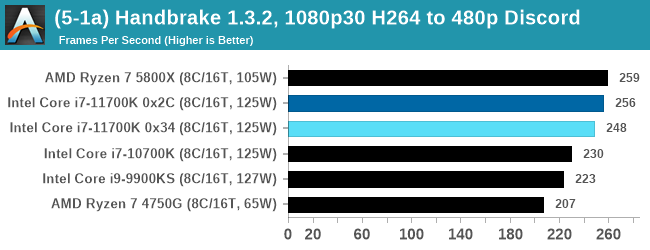
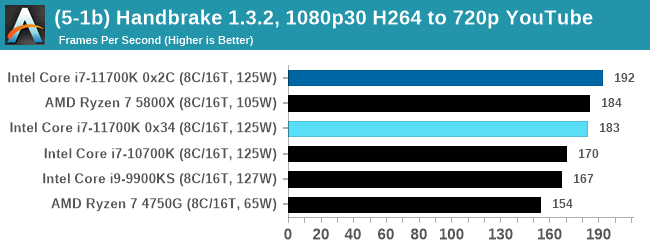
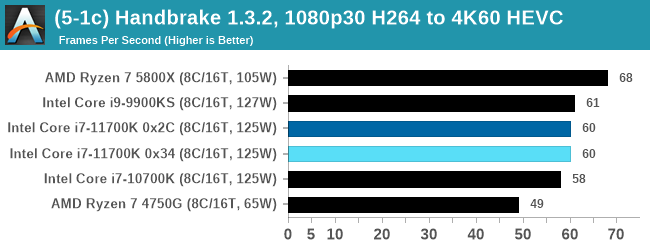
Up to the final 4K60 HEVC, in CPU-only mode, the Intel CPU puts up some good gen-on-gen numbers.
7-Zip 1900: Link
The first compression benchmark tool we use is the open-source 7-zip, which typically offers good scaling across multiple cores. 7-zip is the compression tool most cited by readers as one they would rather see benchmarks on, and the program includes a built-in benchmark tool for both compression and decompression.
The tool can either be run from inside the software or through the command line. We take the latter route as it is easier to automate, obtain results, and put through our process. The command line flags available offer an option for repeated runs, and the output provides the average automatically through the console. We direct this output into a text file and regex the required values for compression, decompression, and a combined score.
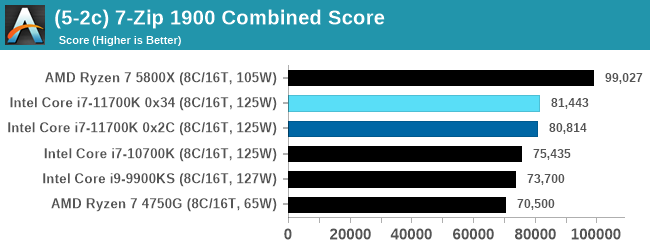
An increase over the previous generation, but AMD has a 25% lead.
AES Encoding
Algorithms using AES coding have spread far and wide as a ubiquitous tool for encryption. Again, this is another CPU limited test, and modern CPUs have special AES pathways to accelerate their performance. We often see scaling in both frequency and cores with this benchmark. We use the latest version of TrueCrypt and run its benchmark mode over 1GB of in-DRAM data. Results shown are the GB/s average of encryption and decryption.
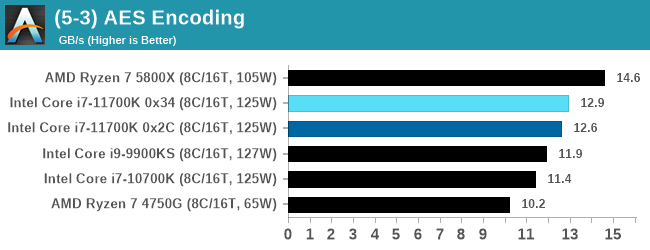
WinRAR 5.90: Link
For the 2020 test suite, we move to the latest version of WinRAR in our compression test. WinRAR in some quarters is more user friendly that 7-Zip, hence its inclusion. Rather than use a benchmark mode as we did with 7-Zip, here we take a set of files representative of a generic stack
- 33 video files , each 30 seconds, in 1.37 GB,
- 2834 smaller website files in 370 folders in 150 MB,
- 100 Beat Saber music tracks and input files, for 451 MB
This is a mixture of compressible and incompressible formats. The results shown are the time taken to encode the file. Due to DRAM caching, we run the test for 20 minutes times and take the average of the last five runs when the benchmark is in a steady state.
For automation, we use AHK’s internal timing tools from initiating the workload until the window closes signifying the end. This means the results are contained within AHK, with an average of the last 5 results being easy enough to calculate.
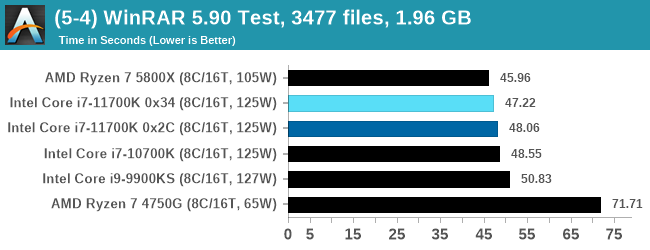
CPU Tests: Legacy and Web
In order to gather data to compare with older benchmarks, we are still keeping a number of tests under our ‘legacy’ section. This includes all the former major versions of CineBench (R15, R11.5, R10) as well as x264 HD 3.0 and the first very naïve version of 3DPM v2.1. We won’t be transferring the data over from the old testing into Bench, otherwise it would be populated with 200 CPUs with only one data point, so it will fill up as we test more CPUs like the others.
The other section here is our web tests.
Web Tests: Kraken, Octane, and Speedometer
Benchmarking using web tools is always a bit difficult. Browsers change almost daily, and the way the web is used changes even quicker. While there is some scope for advanced computational based benchmarks, most users care about responsiveness, which requires a strong back-end to work quickly to provide on the front-end. The benchmarks we chose for our web tests are essentially industry standards – at least once upon a time.
It should be noted that for each test, the browser is closed and re-opened a new with a fresh cache. We use a fixed Chromium version for our tests with the update capabilities removed to ensure consistency.
Mozilla Kraken 1.1
Kraken is a 2010 benchmark from Mozilla and does a series of JavaScript tests. These tests are a little more involved than previous tests, looking at artificial intelligence, audio manipulation, image manipulation, json parsing, and cryptographic functions. The benchmark starts with an initial download of data for the audio and imaging, and then runs through 10 times giving a timed result.
We loop through the 10-run test four times (so that’s a total of 40 runs), and average the four end-results. The result is given as time to complete the test, and we’re reaching a slow asymptotic limit with regards the highest IPC processors.
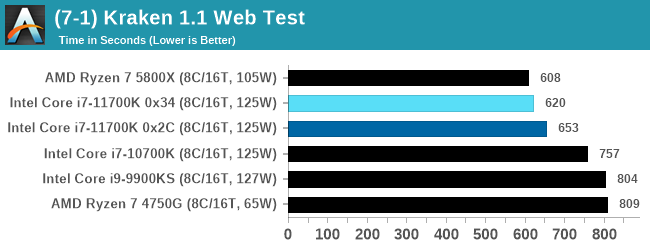
Google Octane 2.0
Our second test is also JavaScript based, but uses a lot more variation of newer JS techniques, such as object-oriented programming, kernel simulation, object creation/destruction, garbage collection, array manipulations, compiler latency and code execution.
Octane was developed after the discontinuation of other tests, with the goal of being more web-like than previous tests. It has been a popular benchmark, making it an obvious target for optimizations in the JavaScript engines. Ultimately it was retired in early 2017 due to this, although it is still widely used as a tool to determine general CPU performance in a number of web tasks.
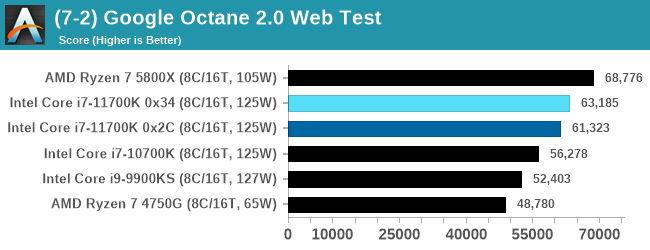
Speedometer 2: JavaScript Frameworks
Our newest web test is Speedometer 2, which is a test over a series of JavaScript frameworks to do three simple things: built a list, enable each item in the list, and remove the list. All the frameworks implement the same visual cues, but obviously apply them from different coding angles.
Our test goes through the list of frameworks, and produces a final score indicative of ‘rpm’, one of the benchmarks internal metrics.
We repeat over the benchmark for a dozen loops, taking the average of the last five.
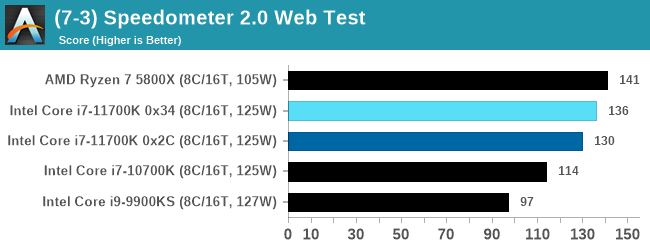
Legacy Tests
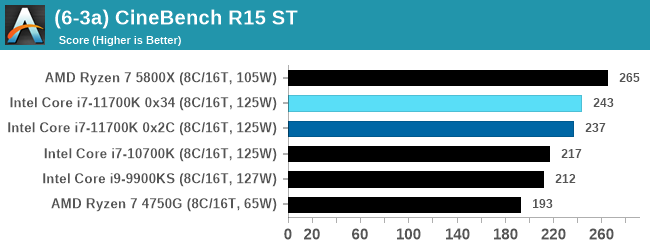
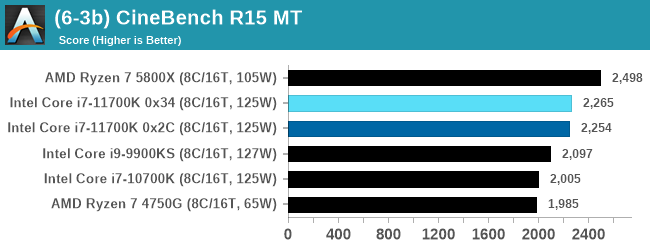
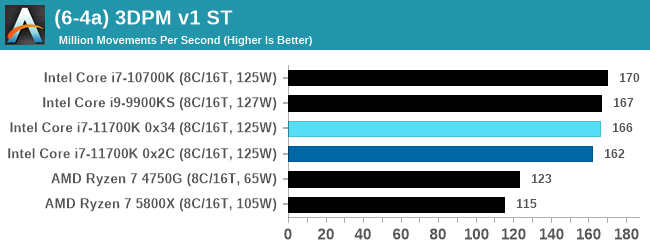
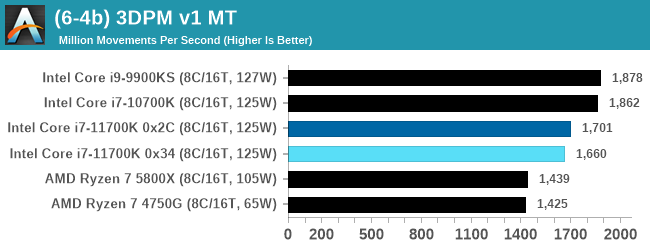


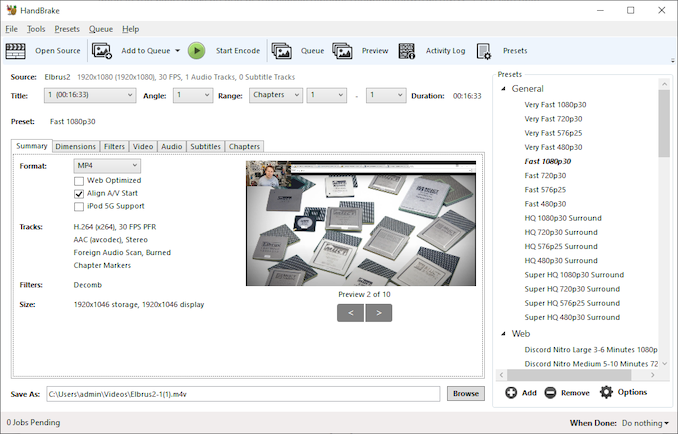
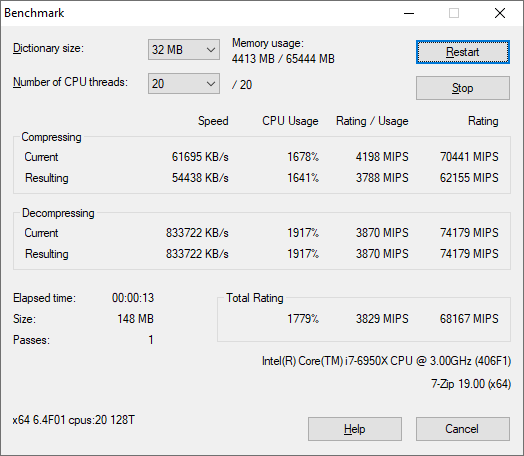
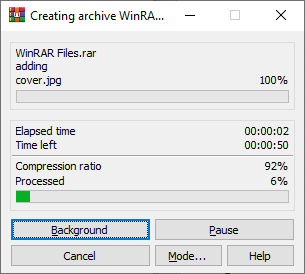

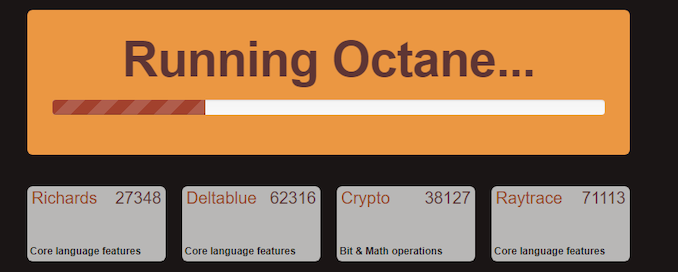
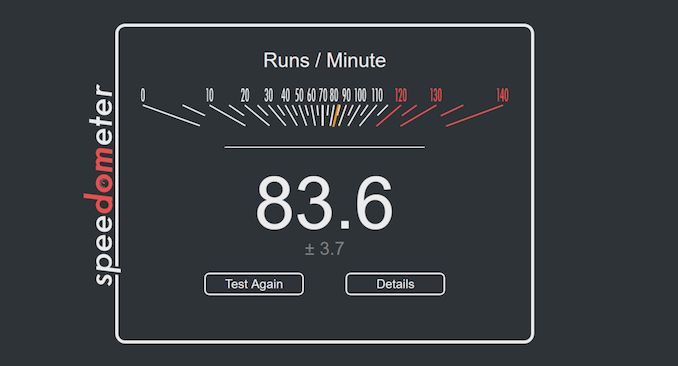








541 Comments
View All Comments
jacropolis - Sunday, March 7, 2021 - link
The 10700K is regularly $279 at Micro Center and isn't a bad buy for that price at all.Jadi - Sunday, March 7, 2021 - link
350 Dollar you want a 10700k and comparing it with a 5800X?Why?
The 5800X don t have a gpu, and the 10700ks was under 320 euros allways!
Now the 10700K not KS cost 316 euros!
Hot a 14nm Chip this is the advantage its only 60 c and a 5800X comes easy over 85 c and more.
More expansiv a 5800X cost 440 euros! A 5600X cost 350 euros, more then the 10700k!
Slower its a K CPU and can boost it up. When you OC the 5800X you have less fps.
Why you think it needs more power? Becouse the 40 sec boost? That is all and under AVX512 is it the only cpu that have it.
Games and other stuff its the same power, And 5800X dosen t stop at 105 Watt it goes like 118 watts. Thats are very close too 125 watts and more is only a limit time!
Spunjji - Monday, March 8, 2021 - link
@Jadi - that last bit of your post makes no sense. The 10700K and 11700K objectively require more power than the 5800X to do the same amount of work; the 5800X only hits 118 Watts under the same conditions that the other two approach 200 Watts. If you're comparing power draw during gaming, the 5800X uses less power than those two - roughly 25W less than the 10700K.Comparing temperatures is daft too. 85 degrees is way under the CPU's junction temperature, so it's not a problem to runa cPU at that temp - and it's objectively easier to keep an AMD CPU at that temperature than to keep an Intel chip at 60 degrees, because your cooler isn't dissipating as much heat.
TrueJessNarmo - Tuesday, March 9, 2021 - link
10700k is $320 on amazon and 9900k is $250 at microcenter.At this point 5900x is best for serious users and 9900k/10700k is for gamers. 5600x and 5800x are overpriced for what it is, but 5900x is a sweet deal at $550
rfxcasey - Wednesday, March 17, 2021 - link
I got my 10700K for 330 dollars new, I've seen them go for as low as 300.Makste - Saturday, March 6, 2021 - link
With gaming it's not the power consumption that's the problem here, it is the gaming performance in these benchmarks against comet lake obviously due to a higher latency.Zen 3's efforts have been put into perspective here, those engineers did quite a commendable job.
Bfree4me - Sunday, March 7, 2021 - link
Agreed! The Zen architecture is top shelf. But it took far too long. My last AMD Cpu was an Athlon 1800 because at that time AMD was the value leader and Intel was the performance king for a price. At the time came where I needed performance over value.So I have been Intel since then. Time to start looking towards Zen 🤔
Timoo - Monday, March 8, 2021 - link
If I may be so free: "Took way too long": I agree.I just keep in mind that it took them way too long, because Intel managed to create some very shady deals with retailers, effectively pushing AMD out of the market and to the brink of bankruptcy. So, for years AMD has been struggling to stay alive.
Agreed, buying ATi didn't help either. But without those shady deals they might have pulled it off. From 2006 to -say- 2015 AMD was only struggling to stay alive. I believe they had some huge cash injection at the time, together with getting one of the best CPU designers in the world (what's his name?) back in the house.
So, in my opinion, AMD is forgiven for their 10-year "heart-attack".
GeoffreyA - Monday, March 8, 2021 - link
I also believe it was because the K10, or Phenom, while being faster than the Athlon 64, was not aggressive enough. It had already been designed before Core 2 Duo came out, and by then, Intel was ahead of them. Who knows, they might have narrowed the gap if they had persisted with the K10 design, widening everything till it matched/surpassed Nehalem, but they shot too far, going for Bulldozer, which was supposed to turn the tables round but sank them further in the ditch.TheinsanegamerN - Monday, March 8, 2021 - link
And yet AMD was having trouble supplying enough chips to the limited market they did have. Much like today. OEMs are not going to sign up with a company that cant consistently supply CPUs.Dont forget the billiosn they poured into making GF and pissing off TSMC in the process.